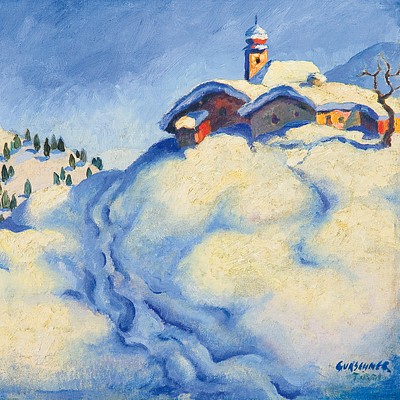KARL ROESSING* (Gmunden 1897 - 1987 Wels)
Lot 82
Estimate:
EUR€8,000 - EUR€14,000
$8,695.65 - $15,217.39
Absentee vs Live bid
Two ways to bid:
- Leave a max absentee bid and the platform will bid on your behalf up to your maximum bid during the live auction.
- Bid live during the auction and your bids will be submitted real-time to the auctioneer.
Bid Increments
| Price | Bid Increment |
|---|---|
| EUR€0 | EUR€10 |
| EUR€100 | EUR€50 |
| EUR€700 | EUR€100 |
| EUR€1,000 | EUR€200 |
| EUR€3,000 | EUR€300 |
| EUR€3,600 | EUR€400 |
| EUR€4,000 | EUR€500 |
| EUR€7,000 | EUR€1,000 |
| EUR€16,000 | EUR€2,000 |
| EUR€30,000 | EUR€3,000 |
| EUR€36,000 | EUR€4,000 |
| EUR€40,000 | EUR€5,000 |
| EUR€150,000 | EUR€10,000 |
About Auction
By Widder Auctions
Nov 23, 2023
Set Reminder
2023-11-23 11:00:00
2023-11-23 11:00:00
America/New_York
Bidsquare
Bidsquare : Masterpieces
https://www.bidsquare.com/auctions/widder-auctions/masterpieces-14076
Masterpieces by Austrian and German artists are coming up for auction in Vienna on November 23rd Widder Auctions office@widderauktionen.com
Masterpieces by Austrian and German artists are coming up for auction in Vienna on November 23rd Widder Auctions office@widderauktionen.com
- Lot Description
KARL ROESSING* (Gmunden 1897 - 1987 Wels)
Still life with shoe trees
oil/canvas, 34,5 x 40 cm
monogrammed KR, dated 24
verso inscribed Karl Roessing, Geschenk von Sabine Bloch Jan. 1984
ESTIMATE € 8000 - 14000
STARTING PRICE € 8000
The Austrian painter, graphic artist and book illustrator Karl Rössing. He mainly created wood engravings, linocuts and wood panel prints as well as oil paintings and picture drawings. Among other things, he processed tendencies of Surrealism and New Objectivity and took inspiration from film and literature. He worked as a university lecturer in Essen, Berlin and Stuttgart. His students included Heinz Kiwitz, Hermann Schardt and Günther Strupp, Ullrich Bewersdorff and Heinz Theuerjahr, Bernd Becher, Robert Förch, Wolfgang Gäfgen, Dieter Groß, Romuald Hengstler, Christine Heuer, Heinrich Heuer, Friedrich Meckseper, Walter Rabe, Malte Sartorius, Günter Schöllkopf, Hermann Sturm, Hans Peter Willberg. Karl Rössing was married to the painter Erika Rössing, née Glöckner, from 1922. From 1913 to 1917 Rössing studied at the Royal School of Applied Arts in Munich, directed by Richard Riemerschmid; he was a member of the German Werkbund. His first exhibition took place in 1915 at the Graphic Cabinet Schmidt-Bertsch in Munich. In 1916 publications in “Die Furche” and “German Student Work in Field and Homeland” followed. His first woodcut was created in 1917, and Rössing received the commission from Emil Kugler to illustrate the “Hausmärchen der Kuglerkinder”, published in 1920. Woodcuts and illustrations formed the first mainstay for Rössing. In 1919 Rössing took part in an exhibition of the New Secession in Munich, where Rainer Maria Rilke noticed him. Josef August Lux invited him to work on the “Art and Culture Council”. In 1921, Rössing took part in the international black and white exhibition of the artists' association “Der Wassermann” with Ernst Barlach, George Grosz, Alfred Kubin and Käthe Kollwitz and received the silver medal from the Republic of Austria. In the same year, Rössing took over the book trade and graphics department at the Folkwangschule in Essen. In 1939 he became a life professor at the State University of Art Education in Berlin. In 1947, Rössing became a life professor at the State Academy of Fine Arts Stuttgart, where he took over the area of free graphics and illustration. He became a member of the German Artists' Association, the “Table of 13” and the international woodcutters' association XYLON; In Austria he and his wife Erika were members of the artists' association MAERZ. Around 1950 Rössing switched from woodcuts to linocuts. In 1977, the Stuttgart Academy showed a retrospective on Rössing's 80th birthday.
PLEASE NOTE:
The purchase price consists of the highest bid plus the buyer's premium, sales tax and, if applicable, the fee of artists resale rights. In the case of normal taxation (marked °), a premium of 24% is added to the highest bid. The mandatory sales tax of 13%, for photographys 20%, is added to the sum of the highest bid and the buyer's premium. The buyer's premium amounts to 28% in case of differential taxation. The sales tax is included in the differential taxation.
- Shipping Info
-
Shipping Terms
We will send you the invoice shortly after the auction. As soon as we have recieved the amount, the art can be picked up at Johannesgasse 9-13, 1010 Vienna. Please note that the buyer is responsible for pick-up and shipping of the lot.
Should you wish to ship your items, please contact:
Mailboxes
Email: oper@mbe-co.at
Tel: 01 5128855
Please note that storage fees may apply, should the pieces not be picked up within 14 days after invoicing for domestic and 28 days for international transportation.
Our team will be happy to assist you with any further information at office@widderauktionen.com or at 0043 676 555 66 10.
-
- Buyer's Premium



 EUR
EUR CAD
CAD AUD
AUD GBP
GBP MXN
MXN HKD
HKD CNY
CNY MYR
MYR SEK
SEK SGD
SGD CHF
CHF THB
THB













